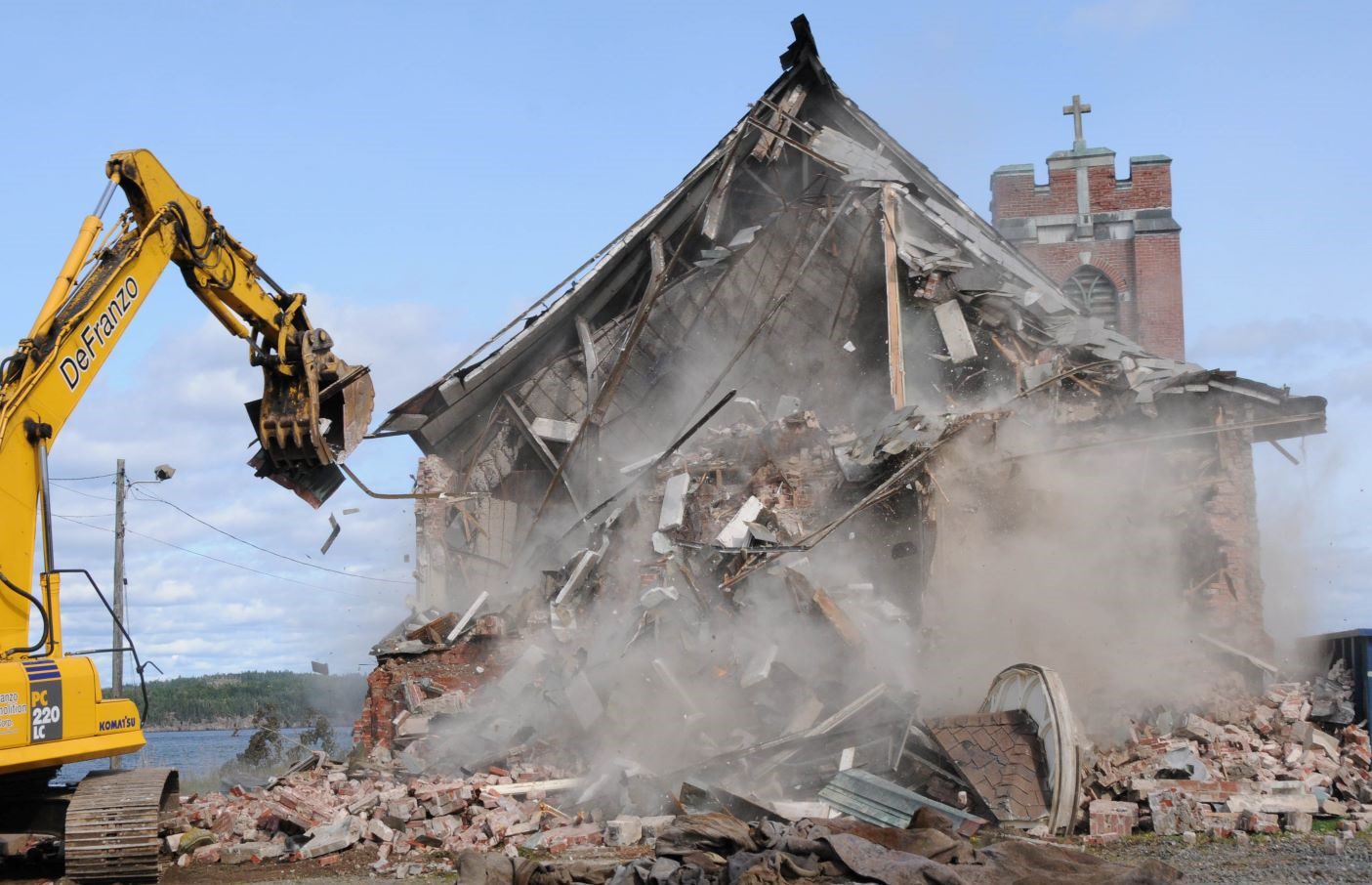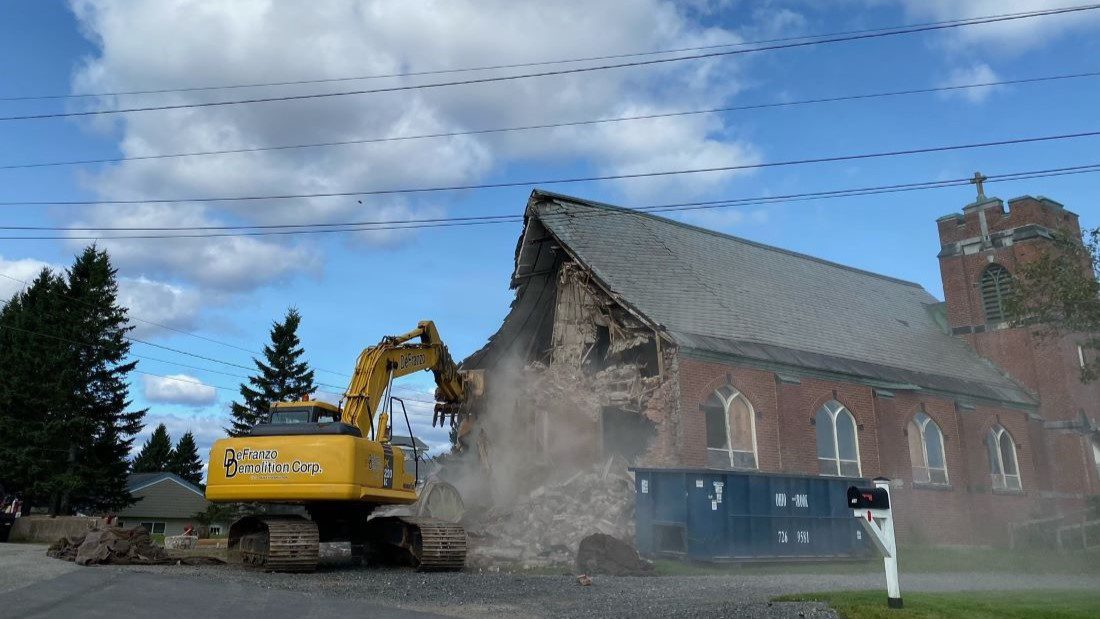St. Ann’s, the historic Catholic church that was built nearly 100 years ago to serve the Passamaquoddy tribal members of Sipayik, was torn down this week, with demolition beginning on September 20.
Although efforts to save the church have been ongoing for the past 10 years, both the Roman Catholic Diocese of Portland and the tribal government at Sipayik agreed on the demolition, which was paid for by the diocese.
“We’re very sad that we’re losing that church. It’s been a long battle — since 2013,” said Hilda Soctomah Lewis, a member of the Friends of St. Ann’s who has been leading the charge to save the building. “It’s a sad day for many of us who felt that the building had value to the reservation. It was a centerpiece of the reservation for many years.”
Not all tribal members, though, wanted to save the structure, and the presence of the Catholic church on the reservation is a sensitive issue.
However, Lewis said, “The historic aspect of the church was very important.”
The church has been closed for a number of years because of concerns about its condition and mold issues, with Mass now celebrated on the reservation at the former cultural building that was used by the Beatrice Rafferty School and is next to St. Ann’s Church.
Although the church was no longer in use, the last part of the funeral Mass for Lewis’ son, David Moses Bridges, a tribal culture-bearer, was held in St. Ann’s. “I’m happy I was able to do that,” she said.
Scott Graff, chief financial officer for the Roman Catholic Diocese of Portland, noted the church’s deterioration over the years and said, “Our concern is for safety, to make sure no one gets hurt.” The diocese does not have any plans for building a new church at the site.
He confirmed the church’s 19 stained glass windows, which were previously removed for safe storage, are owned by the tribe. The windows are considered to be of museum quality, and the workmanship throughout the church is exceptional. Lewis noted tribal members contributed funds both for the stained glass windows and the building of the church.
Tony DeFranzo of DeFranzo Demolition Corporation of Raymond, N.H., said it may take up to two weeks to complete the demolition project.

Everything that the tribe wanted saved has been removed from the church, including the stained glass windows, the bell and the pews. The time capsule that had been placed in the brickwork of the church was removed and then opened in the tribal office gym on Thursday, September 21.
Over the years the Friends group had tried to start fundraising efforts but was not allowed to do so by the diocese, Lewis said, since they did not own the building. While the land the church is on belongs to the tribe, the diocese and the tribe have not been able to identify who actually owns the building.
While the Friends of St. Ann’s has dwindled in its numbers, Lewis is planning to form a nonprofit to obtain grant funds to build another structure, perhaps a replica of the older wooden church that was on the site or another building that could serve as a spiritual and cultural center for the tribe.
She will be seeking tribal council approval for using the land to construct such a building and then hopes to begin a capital campaign throughout the country. She said the church’s stained glass windows would be placed in the new building.
Efforts to save church
Estimates on the cost to restore the church have varied over the years. Last February an estimate obtained from a masonry firm was for $680,000 to remove and replace the exterior bricks on the church and bell tower.
A 2013 report funded by the National Park Service, though, placed a cost estimate of over $1 million for the building. Then a 2019 assessment conducted for the diocese had estimated the cost for renovating the church at $4 million and for restoring it at $4.43 million. A fact sheet accompanying a proposed referendum that was not held in 2022 on whether to demolish the church stated that renovation costs would be $7 million to $10 million.
The proposal for a referendum had come up during a series of meetings held by the Sipayik Tribal Council. In March 2022 the tribal council had voted to accept the diocese’s proposal to demolish the church at their own expense. Then in February 2023 the council approved a motion to postpone the demolition so that a referendum vote could be held on whether or not to tear down the building.
However, at a March 29 administrative meeting with tribal councillors, which was not a formal council meeting, a consensus was reached, following a presentation by tribal attorney Craig Francis, to not hold the referendum and to allow the demolition to proceed.
Francis relayed that, if the planned demolition was delayed, the diocese indicated the tribe would be responsible for the demolition costs, according to Lewis, who was at the meeting. At a meeting this past August, the council decided not to take any action on delaying the demolition, noting they had already approved in March 2022 a motion for tearing down the building.
Although the church may no longer be the centerpiece of the reservation, when it was built in 1928 to replace the former wooden church that was destroyed by a fire it became the pride and joy of the community, according to historical accounts, and Lewis has written that tribal members feel a deep connection to the building.
In a proposal she had submitted to restore the building, Lewis wrote, “Community members have been baptized, received communion, confirmation, have been married, have seen their children and grandchildren receive the same and have passed through this church on their final funeral service.”
Now it is the church itself that is passing away and, by at least some tribal members, being mourned for the loss to the community.
This story was originally published by the Quoddy Tides, and is republished here with permission.







